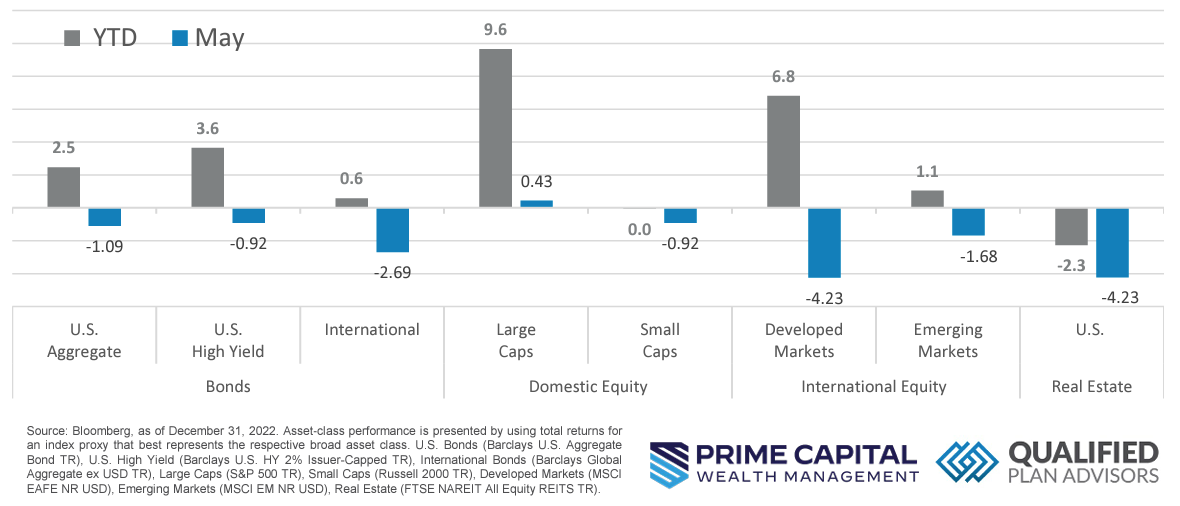Quick Takes
- Risk Assets Post Dismal May. Risk assets had a rocky month of May, with Bonds stumbling and almost all equities were right there with them, the exception being Large Cap US equities posted a modestly positive month.
- Cooling Inflation Data. Inflation, as measured by the CPI data release, came in slightly softer than expected, possibly hinting that inflation is on the downward trend. Core PCE, the Fed’s preferred inflation metric, came in slightly above expectations for the month of May.
- Dollar Rebounds. The dollar spent the majority of the month in a steady grind higher, despite fears that the US government might not reach a resolution on the Debt Ceiling Limit before the government runs out of cash.
- Labor Markets, Economic Production, and Personal Spending. Unemployment ticked down yet again to 3.4% versus expectations of 3.6%. GDP for the first quarter of the year was revised slightly higher from the government’s initial estimate of 1.1% to +1.3%. Personal Spending came in well above expectations of +0.3%, landing at +0.8%.
Asset Class Performance
The month of May closed out with somewhat depressing results as almost all asset classes were negative for the month. Large Cap US equities were able to post a modestly positive month. With the exception of Real Estate, most asset classes are still clinging to a healthy YTD gain.
Markets & Macroeconomics
For the previous month, Inflation, as measured by the CPI, came in below expectations of +5.0% on the year-over-year metric, landing at +4.9% for the May reading. While this slightly softer than expected reading may not seem impactful, digging into the underlying data, there were several aspects that made the outlook much rosier. As illustrated in the chart above, Energy prices actually detracted from the overall reading, which isn’t much of a surprise considering the recent softening of oil prices combined with declining demand due to a slowdown in economic production across the globe. More importantly, Housing and Services each posted their smallest advance since the summer of 2022. Both of these datapoints are areas that the Federal Reserve is keeping a watchful eye on as they have been some of the largest contributors to putting pressure on consumers, especially those at the lower income side of the spectrum. While the disinflationary aspects of the Housing and Service sectors in encouraging from an inflation, and ultimately tightening of monetary policy, perspective, the implications for the overall real estate market could be less exciting. On the back of the rapid increase in interest rates leading to tighter lending standards, which was then further exacerbated by the turmoil in the banking sector earlier in the year, it’s possible that this slowdown in the housing sector could be the beginning of something disastrous for the US. A further drawdown in the US real estate sector, especially commercial properties that were damaged by the global pandemic, could impact consumers and investors alike. Economic data releases for the month of May related to the Housing sector painted a mixed picture, but it will likely be an area that investors and the Fed keeps a close watch on in the coming months.
Bottom Line: Inflation, as measured by the CPI, came in softer than expected for the May reading. While it was only slightly below survey estimates, the underlying datapoints showed that most categories are showing signs of disinflation, i.e., inflation is increasing at a slower pace, especially some of the sectors that were most impactful to consumers like Housing and Services inflation. If inflation continues to show signs of moderation in the coming months, this could mean that the end of the Fed’s hiking cycle is over. While the inflation reading was showing positive signs, some of the collateral damage from the Fed’s rapid tightening of monetary conditions may not have worked its way through the system yet. The impact on the overall real estate market, especially commercial real estate, is still unknown and will be worth watching in the future.
©2023 Prime Capital Investment Advisors, LLC. The views and information contained herein are (1) for informational purposes only, (2) are not to be taken as a recommendation to buy or sell any investment, and (3) should not be construed or acted upon as individualized investment advice. The information contained herein was obtained from sources we believe to be reliable but is not guaranteed as to its accuracy or completeness. Investing involves risk. Investors should be prepared to bear loss, including total loss of principal. Diversification does not guarantee investment returns and does not eliminate the risk of loss. Past performance is no guarantee of comparable future results.
Source: Bloomberg. Asset‐class performance is presented by using market returns from an exchange‐traded fund (ETF) proxy that best represents its respective broad asset class. Returns shown are net of fund fees for and do not necessarily represent performance of specific mutual funds and/or exchange-traded funds recommended by the Prime Capital Investment Advisors. The performance of those funds June be substantially different than the performance of the broad asset classes and to proxy ETFs represented here. U.S. Bonds (iShares Core U.S. Aggregate Bond ETF); High‐Yield Bond (iShares iBoxx $ High Yield Corporate Bond ETF); Intl Bonds (SPDR® Bloomberg Barclays International Corporate Bond ETF); Large Growth (iShares Russell 1000 Growth ETF); Large Value (iShares Russell 1000 Value ETF); Mid Growth (iShares Russell Mid-Cap Growth ETF); Mid Value (iShares Russell Mid-Cap Value ETF); Small Growth (iShares Russell 2000 Growth ETF); Small Value (iShares Russell 2000 Value ETF); Intl Equity (iShares MSCI EAFE ETF); Emg Markets (iShares MSCI Emerging Markets ETF); and Real Estate (iShares U.S. Real Estate ETF). The return displayed as “Allocation” is a weighted average of the ETF proxies shown as represented by: 30% U.S. Bonds, 5% International Bonds, 5% High Yield Bonds, 10% Large Growth, 10% Large Value, 4% Mid Growth, 4% Mid Value, 2% Small Growth, 2% Small Value, 18% International Stock, 7% Emerging Markets, 3% Real Estate.
Advisory products and services offered by Investment Adviser Representatives through Prime Capital Investment Advisors, LLC (“PCIA”), a federally registered investment adviser. PCIA: 6201 College Blvd., Suite#150, Overland Park, KS 66211. PCIA doing business as Prime Capital Wealth Management (“PCWM”) and Qualified Plan Advisors (“QPA”). Securities offered by Registered Representatives through Private Client Services, Member FINRA/SIPC. PCIA and Private Client Services are separate entities and are not affiliated.
© 2023 Prime Capital Investment Advisors, 6201 College Blvd., Suite #150, Overland Park, KS 66211.


